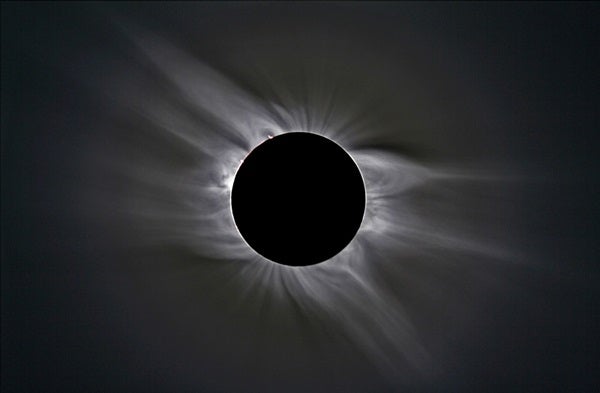

People will travel thousands of miles for the chance to glimpse delicate detail in the Sun’s corona during a total solar eclipse. Their next opportunity arises March 20 when the Moon completely hides the Sun’s photosphere for viewers in the waters south and east of Iceland.
Leslie Marczi
Spring returns to Earth’s Northern Hemisphere in March, and, this year at least, the annual rebirth of our home world coincides with the evening appearance of several bright planets. Brilliant Venus rules the western sky, where it stands near the subtler glow of ruddy Mars. In the opposite direction, Jupiter dominates the starry background. Just one month past its annual peak, the giant planet climbs higher with each passing day. Although the morning sky seems subdued in comparison, you won’t want to miss Saturn as it adds to the luster of Scorpius the Scorpion.
But the month’s biggest event occurs in daylight hours. On March 20, the New Moon passes directly in front of the Sun and brings a total solar eclipse to observers along a path that arcs south and east of Iceland. Although the track of totality lies mostly over open water, it does make landfall in the Danish Faroe Islands (located approximately halfway between Iceland and Norway) and Norway’s island of Spitsbergen. Maximum eclipse occurs east of Iceland, where the Moon blocks the Sun for
2 minutes and 47 seconds.
People across most of Europe experience a significant partial eclipse. From the United Kingdom, Ireland, and Scandinavia, the Moon covers more than 80 percent of the Sun. Residents in the rest of northern Europe witness at least 60 percent coverage. The southern limit of partial eclipse visibility stretches across northern Africa and then through Saudi Arabia, Iraq, and Iran before ending in northern China.
The night sky offers its own rewards, however, and they are available to viewers across the globe. As March opens, Venus and Mars hang near each other in the western sky as darkness falls. Venus shines at magnitude –3.9 and shows up within 20 minutes of sunset. Mars glows at magnitude 1.3 — less than 1 percent as bright as its neighbor — and the sky needs to darken considerably for it to emerge. By 7 p.m. local time, both appear conspicuous. Venus stands 15° high, and Mars hangs 4° below it. Binoculars will deliver the best views of the planetary pair.
As March progresses, the apparent gap between the two worlds grows. Mars orbits farther from the Sun than does Earth and thus moves more slowly than our planet. The relative motion soon will carry Mars behind the Sun from our viewpoint. Meanwhile, Venus follows a faster inside track and is pulling away from the solar glow. By March 21, 13° separate the two planets.
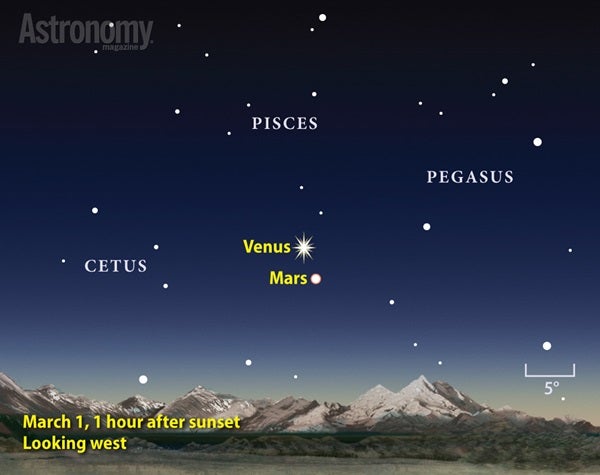
Brilliant Venus points the way to ruddy Mars in early March when the two planets lie near each other in evening twilight.
All illustrations: Astronomy: Roen Kelly
By then, however, a third solar system object has joined the pair. A slender crescent Moon passes 1° south (to the left) of Mars that evening. A slightly fatter Moon slides 3° south of Venus the next night. As March closes, Venus stands 17° above Mars, and the Red Planet appears about 10° above the western horizon 45 minutes after sunset.
When viewed through a telescope, Venus shows slight changes this month. On the 1st, its disk measures 12″ across and the Sun illuminates 86 percent of it. By the 31st, the planet spans 14″ and appears 78 percent lit. Mars pales considerably in comparison: Its 4″-diameter disk shows no detail.
Lurking in the background of the Venus-Mars tandem is the ice giant planet Uranus. A 6th-magnitude object, it usually is not easy to spot when low in the sky, but March 4 is an exception. That evening, the distant world appears less than a Full Moon’s diameter below Venus. Look for the two through binoculars or a telescope some 10° high and due west at 7:30 p.m. local time, once the sky has darkened totally.
While Venus dominates the western sky after sunset, Jupiter does the same in the east. Although the gas giant reached opposition and peak visibility in February, its appearance hardly suffers in March. Jupiter gleams at magnitude –2.4 at midmonth — only the Moon and Venus shine brighter. And the solar system’s largest planet climbs high earlier on March evenings, appearing at least two-thirds of the way to the zenith (the point directly overhead) for about three hours.
Jupiter lies in Cancer the Crab, a faint constellation nestled between Gemini the Twins and Leo the Lion. The world’s westward motion relative to these background stars slows considerably during March. By month’s end, it stands 5° east of Cancer’s finest deep-sky object: the Beehive star cluster (M44).
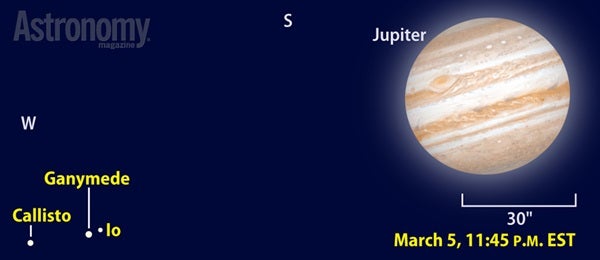
A riveting sequence of mutual events occurs March 5/6. Within a two-hour period starting at 11:50 p.m. EST, Io both occults and eclipses Ganymede.
Although Jupiter looks dazzling to the naked eye, it appears truly stunning when viewed through a telescope. The best views come when it lies high in the sky during late evening. The greater altitude means the planet’s light passes through less of Earth’s turbulent atmosphere, providing crisp views of fine details.
Jupiter spans a robust 43″ in mid-March. That’s plenty big enough to reveal the planet’s two equatorial belts, dark bands that run parallel to each other and sandwich a brighter zone. During moments of good seeing, when the air above you settles down and the view sharpens, you should see an alternating series of bright zones and darker belts.
Jupiter’s appeal doesn’t end at its cloud tops. The planet controls a family of more than 60 moons, four of which glow brightly enough to show up through any telescope. If you don’t see four white dots lined up next to Jupiter, it means one or more of the moons is passing in front of or behind the giant world — events worth viewing in and of themselves.
An excellent example occurs when Ganymede emerges from Jupiter’s shadow March 20. The moon starts to reappear at 10:43 p.m. EDT and takes seven minutes to return to full sunlight. Ganymede then lies one planet diameter east of Jupiter and just 3″ west of Io, which serves as a convenient guide.
In addition to these run-of-the-mill satellite events (which occur every month), the moons currently are experiencing a rare series of so-called mutual events. Once every six years, Earth and the Sun pass through the plane of the satellites’ orbits. Around this time, one moon may cross in front of another (an occultation) or enter another’s shadow (an eclipse). North American observers can witness dozens of such events during March.
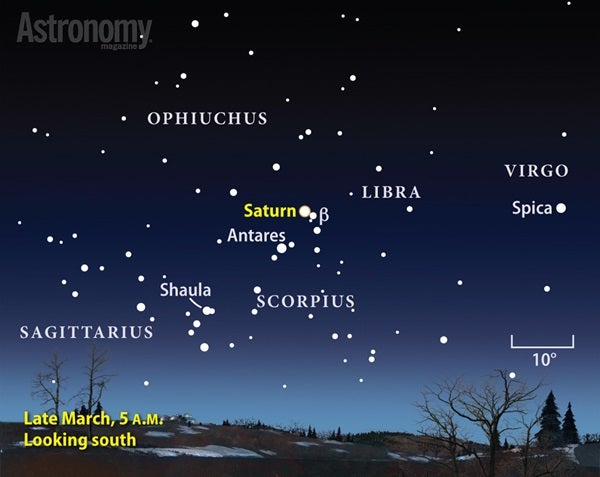
Now just two months from opposition and peak visibility, the ringed planet looks stunning among the background stars of northern Scorpius.
A particularly exciting sequence happens the night of March 5/6 when three moons participate in four mutual events. The action starts at 7:19 p.m. EST when Io partially occults Europa for two minutes. To observers in eastern North America, the two inner moons will appear to merge. Less than an hour later, Europa passes through Io’s shadow. Europa dims noticeably at the middle of this eclipse, which lasts from 8:14 to 8:18 p.m. Half an hour after the eclipse ends, Europa disappears behind Jupiter’s western limb.
Io performs a similar dance with Ganymede later that night. Viewers throughout North America can watch Io occult Ganymede beginning at 11:50 p.m. EST. At the midpoint of this eight-minute event, Io’s disk appears completely inside that of the solar system’s largest moon. During this occultation, Jupiter’s fourth major moon, Callisto, stands nearby. Io passes less than 3″ north of the outermost satellite at 12:50 a.m. EST. The night’s activities wind up when Io’s shadow washes over Ganymede between 1:35 and 1:46 a.m.
The “claws” of Scorpius the Scorpion grip magnitude 0.4 Saturn throughout March. The ringed planet spends the month within a Full Moon’s width of magnitude 4.1 Nu (ν) Scorpii, the claws’ northernmost star. The gas giant world rises before 1 a.m. local time March 1 and two hours earlier by the 31st.
Saturn climbs highest in the south around the break of dawn. That’s the best time to target the planet through a telescope. As with Jupiter, greater altitude means sharper views. Even small scopes reveal Saturn’s magnificent rings, which span 39″ and tilt 25° to our line of sight in mid-March. Note in particular the dark Cassini Division that separates the outer A ring from the brighter B ring.
Any scope also will show you 8th-magnitude Titan, Saturn’s largest moon. This planet-sized world orbits Saturn once every 16 days. You can find it due north of the planet March 1 and 17 and due south March 9 and 25. A handful of fainter satellites shows up through 4-inch and larger instruments. Look for 10th-magnitude Tethys, Dione, and Rhea inside Titan’s orbit. Distant Iapetus, which takes 79 days to circle Saturn, also glows at 10th magnitude when it lies farthest west of the planet in early March.
The solar system’s two other major planets essentially remain hidden throughout March. Mercury scrapes the east-southeastern horizon early in the month, appearing a mere 3° high 45 minutes before sunrise. And distant Neptune rises in twilight an hour before the Sun as the month closes. Both will become more conspicuous later this spring.
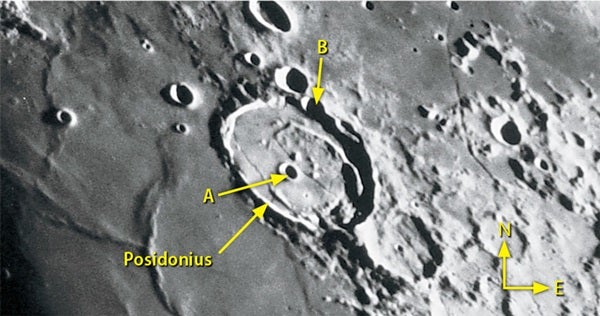
Intricate detail covers the floor of 59-mile-wide Posidonius, making the crater a worthy target whenever the Sun illuminates it.
Consolidated Lunar Atlas/UA/LPL
A FORTNIGHT OF FABULOUS FEATURES
Packed with detail, the 59-mile-wide crater Posidonius ranks near the top of every Moon-lover’s list. This ancient impact feature stands out in the Moon’s northeastern quadrant. Its lava-filled interior sports cracks, jumbled peaks that poke up from the floor, an off-center craterlet, and bright segments where the walls have slumped inward.Unlike craters that vanish at Full Moon, Posidonius boasts a bright rim with a face full of detail. The various shades of gray come from differences in reflectivity — what astronomers call “albedo.” The dark lava on the crater’s floor contrasts nicely with the bright specks of small impact events and the long arc of a slumped terrace whose face aims skyward.
This mesmerizing scenery lasts through March’s first week until sunset arrives over the region the evening of the 9th. The shadows and highlights will be reversed compared to the image at right, which shows the view shortly after sunrise (which occurs on the 25th this month). As sunset approaches, watch the features become increasingly exaggerated as their shadows lengthen. Also take note of two companion craters. Posidonius B is a conspicuous 9-mile-wide gash on the main crater’s northeastern rim, while Posidonius A is the slightly smaller craterlet just west of the big impact feature’s center. Both have the sharp edges of youth, though in the Moon’s case, young means roughly 100 million years old.
Many people think Posidonius is named after Poseidon, the Greek god of the sea. But the crater actually takes its name from the Greek astronomer and philosopher Posidonius, who lived from around 135 to 51 b.c.
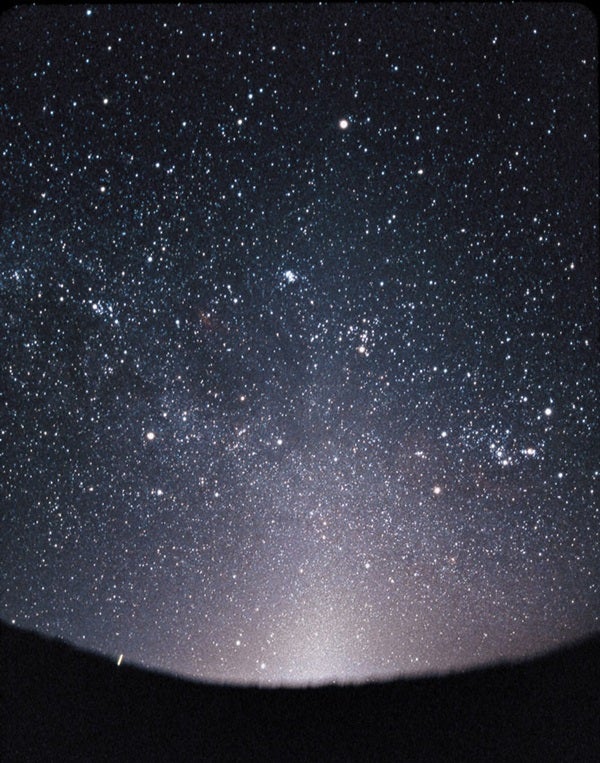
Mid-March provides observers with their best chance this year to view the zodiacal light’s subtle glow after sunset.
Rob Ratkowski
SPRING’S DUSTY EVENING GLOW
Trillions of meteoroids show up on March evenings, but you need ideal conditions to see them. Only a few of these fine dust particles penetrate Earth’s atmosphere and burn up in the process, creating the bright streaks of light called meteors. Most scatter across the inner solar system in the plane of the planets’ orbits.
Moonless evenings in March are the best time to see this dust. Sunlight reflects off the dust, creating the beautiful and ethereal zodiacal light. Find a dark observing site, and gaze due west as twilight fades to night. As soon as the Milky Way appears, look for a faint cone of light extending along the ecliptic from the horizon to Taurus. Try your luck any clear evening from around March 8 to 21.
| WHEN TO VIEW THE PLANETS | ||
| Evening Sky | Midnight | Morning Sky |
| Venus (west) | Jupiter (southwest) | Mercury (southeast) |
| Mars (west) | Saturn (south) | |
| Jupiter (southeast) | Neptune (east) | |
| Uranus (west) | ||
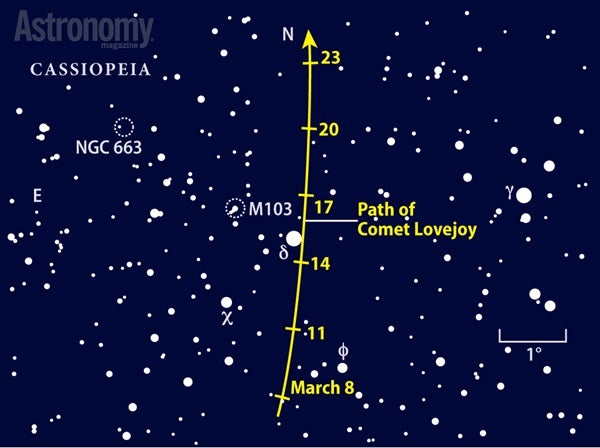
The northern Milky Way in Cassiopeia makes a dramatic backdrop for the passage of this 10th-magnitude visitor from the distant Oort Cloud.
CAVORTING WITH CASSIOPEIA’S CLUSTERS
The fifth discovery of Australian amateur astronomer Terry Lovejoy, Comet C/2014 Q2, is now headed back to the depths of the solar system. On its outbound journey this month, it crosses the rich Milky Way background of Cassiopeia the Queen.
Because of its position in the far northern sky, the comet remains visible all night during March. The best observing window comes in the month’s middle two weeks, however, when Lovejoy rides high in the moonless evening sky.
Comet Lovejoy has a few stellar encounters during the peak mid-March observing period. It passes 0.1° west of magnitude 2.7 Delta (δ) Cassiopeiae on the 15th, though it may be hard to spot the comet so close to the bright star’s glare. Better views likely will come the next few evenings when Lovejoy slides past two 7th-magnitude open star clusters. On the 16th and 17th, it appears 1° west of M103; on the 20th, it lies 3° west of NGC 663. The comet should glow around 10th magnitude — not at all difficult to see through a 6-inch telescope and picturesque in wide-field images.
Comet observers rely on these random arrivals from the distant Oort Cloud to spice up their viewing sessions — C/2014 Q2 saved us from a couple months of really faint targets. And we need another because no currently known comets are expected to top 11th magnitude during April or May.
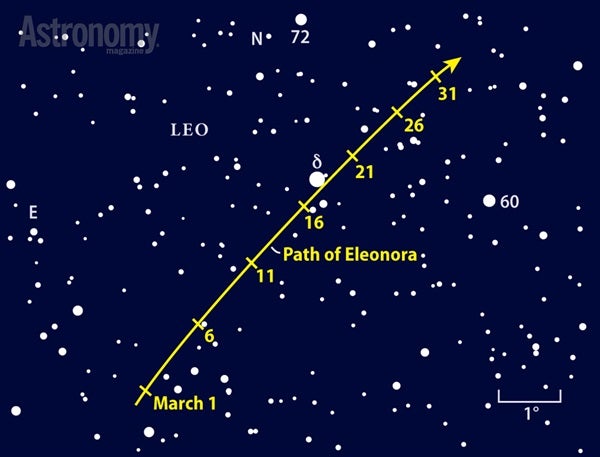
Main-belt asteroid Eleonora glows at 10th magnitude as it crosses a star-poor region in the hindquarters of Leo the Lion.
ON A TAILSPIN IN LEO
Asteroid 354 Eleonora lies within a Full Moon’s diameter of magnitude 2.6 Delta (δ) Leonis, the northernmost star in Leo the Lion’s tail, from March 17 to 19. The proximity of the two makes it easy to spot the asteroid, and it’s an opportunity you won’t want to pass up. A 3-inch telescope can capture the main-belt object from the city.
But there’s no guarantee. A spell of poor weather or a similarly bright background star might thwart you. Which dot in the eyepiece is the 95-mile-wide rock? Sketch the field including four or five stars, and then return to it a night or two later. The “star” that moved is Eleonora.
This high-numbered asteroid reaches opposition and peak visibility in early March, when it glows at magnitude 9.6. Luckily, Leo lies far from the Milky Way’s profusion of stars. On March 20 and 21, in fact, Eleonora sits in front of a nearly blank zone dotted with only a handful of 12th-magnitude pinpricks.
French astronomer Auguste Charlois discovered Eleonora floating among the background stars of Cancer in January 1893. It eluded discovery for so long because its orbit inclines a fair bit to the ecliptic, which often takes Eleonora well north or south of the zone where planets and most asteroids reside.
Martin Ratcliffe provides planetarium development for Sky-Skan, Inc. from his home in Wichita, Kansas. Meteorologist Alister Ling works for Environment Canada in Edmonton, Alberta.









